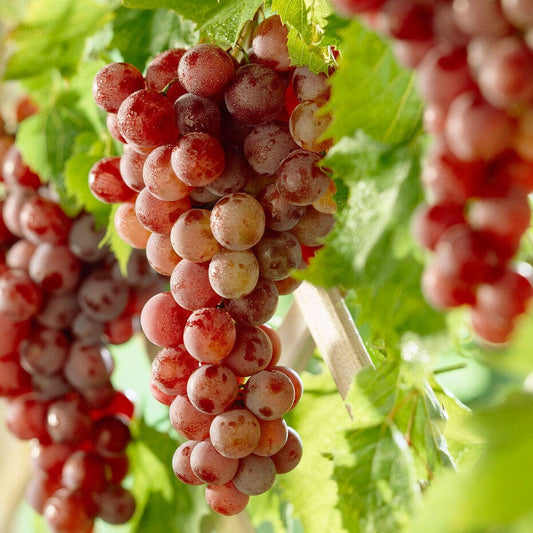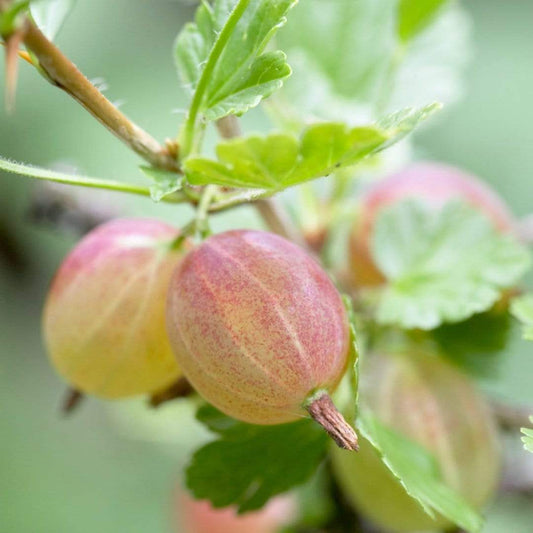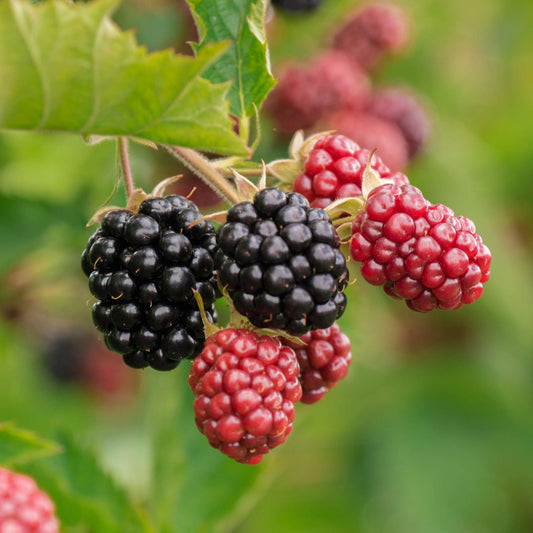Hybrid Berries: Fantastic Berries and Where to Find Them

Hybrid working, hybrid cars, hybrid bikes - all brilliant inventions that combine two good things to make something even better. Well, mostly. But hybrids are nothing new - fruit growers have been at it for years, and many of our favourite fruits, such as the grapefruit and the banana (as we know it), were originally a cross between two different breeds.
In the soft fruit world, hybrid berries have been some of the most interesting innovations.
What are hybrid berries?
Hybrid berries are a combination of at least two different cane fruits, usually blackberries and raspberries, which have the best qualities of each ‘parent’ berry. By crossing fruits in this way, growers can improve the taste and size of berries as well as breeding varieties that are thornless, more compact, more disease resistant or yield more fruit. Berries are a particularly successful fruit to hybridise, with some new crosses becoming even more popular than their parent fruits. Take the Tayberry for example.
The Tayberry, a blackberry/raspberry cross, is probably the best known and most successful hybrid berry. It was first bred in Scotland in the 1970s and named after the nearby River Tay. The red-purple berries are bigger than raspberries and super sweet but they can’t be harvested by machine, which is why you don’t see them sold in shops. However gardeners love them and they’re very popular on allotments. The Tayberry was quickly awarded the RHS Award of Garden Merit, but that’s just the start of our quest for fantastic berries - there’s a magical world of hybrids out there if you know where to look!
Loganberry
Loganberries are also a cross between a blackberry and a raspberry. They’re the product of a happy accident in 1881 when James Harvey Logan, a Californian judge and horticulturist, found a cross between a North American blackberry and a European red raspberry growing in his backyard. The plant and berries look more like blackberries, but the colour is more raspberry-like and the flavour is halfway between the two. Once word got out about how good they were, Loganberries became a favourite choice for cooking, being quite sharp and holding their shape well - a thornless variety was bred (deliberately this time) in 1933.
Jostaberry
A surprisingly brilliant combination of a blackcurrant and a gooseberry, Jostaberries were first bred by an amateur (honest!) called Charles Welch in Norfolk. They’re the size of gooseberries and have the colour and vitamin C content of blackcurrants, losing the prickly hairs of the former but gaining their size - the best of both worlds! Jostaberry plants can be grown as freestanding shrubs or trained against a wall, and once established, they can produce up to 4-5kg of fruit per plant. Ripe berries are sweet enough to eat fresh with cream, but they’re also good in pies, crumbles and jams.
Pineberry
The pineberry is a hybrid of two strawberries - the wild South American and the North American varieties. They look like inverted strawberries, with white skin and red seeds, but they taste and smell like pineapple. Pineberries are not just a cute gimmick - their unique colour fools hungry birds into thinking they’re not ripe and leaving them alone - meaning you get to enjoy them all yourself!

Some berries are hybrids of hybrids! These include:
Tummelberry
This hybrid berry is a Scottish-bred variation on the Tayberry, with a similar flavour to the Loganberry - many people think it’s superior. It’s a cross between a Tayberry and a top secret hybrid with the memorable name of Seedling 69102/18. Named after another Scottish river, Tummelberries are relatively new to the hybrid scene, but looks very promising, with a long harvesting season, heavy yields and excellent winter hardiness. The Tummelberry has large, rounded juicy berries with a bright red colour and intense flavour. They make fantastic jams and ice creams, and keep their shape well when frozen.
Boysenberry
Boysenberries are a hybrid of a Loganberry and a Dewberry (a naturally mutated, trailing blackberry).
So its heritage is a mixture of European raspberry, European blackberry, American dewberry and Loganberry. With such a pedigree, it’s no surprise that Boysenberries are delicious, thornless and easy to grow. Boysenberries are named after the grower Rudolph Boysen, but they were cultivated by Walter Knott in the 1930s. They look like large, deep purple blackberries and taste like them too, only sweeter. The plants are long lived perennials which are cold-tolerant and easy to harvest.
Youngberry
Youngberries were created by a Louisiana businessman named Byrnes M Young in 1905. He’d been trying unsuccessfully to breed hybrid berries for years, and finally arrived at this successful variety by breeding a raspberry-blackberry hybrid called the Phenomenal Berry (bred by Luther Burbank, who we suspect may have moonlighted as a DC Comics villain) with a dewberry. The result is similar to a Boysenberry and thornless varieties have since been created.
Chuckleberry
This new fruit is a hybrid of a redcurrant, gooseberry and jostaberry with hints of each in its flavour. The plants grow similarly to blackcurrants and produce heavy crops of large, sweet, juicy berries that look like large blackcurrants with red flesh inside. Chuckleberries were first created by Charles Welch of Jostaberry fame in the mid 2000s - those who’ve been lucky enough to try it say that it makes the best jam ever!
Why grow hybrid berries?
While it’s always more fun to grow things you can’t get in the shops, you also want your fruit plants to work hard for their garden space. Fortunately by growing hybrid berries you can tick both boxes - they’re a great addition to your soft fruit patch and will grow happily amongst their relatives - raspberries, blackberries, strawberries, currants or gooseberries. What’s more, hybrids are often better performers, so they’re a good choice if your growing space is limited, giving better yields for longer - and if the thorns have been bred out of them, so much the better. If nothing else, they’re an excellent talking point!
Discover more unusual fruit plants you can grow.
Last updated: 13/11/2023




















